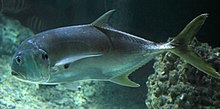| Carangidae Temporal range:
| |
|---|---|

| |
| Crevalle jack, Caranx hippos | |
| Scientific classification | |
| Domain: | Eukaryota |
| Kingdom: | Animalia |
| Phylum: | Chordata |
| Class: | Actinopterygii |
| Order: | Carangiformes |
| Suborder: | Carangoidei |
| Family: | Carangidae Rafinesque, 1815 |
| Subfamilies | |
|
See text | |
The Carangidae are a family of ray-finned fish that includes the jacks, pompanos, jack mackerels, runners, trevallies, and scads. It is the largest of the six families included within the order Carangiformes. Some authorities classify it as the only family within that order but molecular and anatomical studies indicate that there is a close relationship between this family and the five former Perciform families which make up the Carangiformes.[1]
They are marine fishes found in the Atlantic, Indian and Pacific Oceans. Most species are fast-swimming predatory fishes that hunt in the waters above reefs and in the open sea; some dig in the sea floor for invertebrates.[2]
The largest fish in the family, the greater amberjack, Seriola dumerili, grows up to 2 m in length; most fish in the family reach a maximum length of 25–100 cm.
The family contains many important commercial and game fish, notably the Pacific jack mackerel, Trachurus symmetricus, and the other jack mackerels in the genus Trachurus.[2]
Many genera have fairly extensive fossil records, particularly Caranx and Seriola, which extend into the early Paleogene (late Thanetian), and are known from whole and incomplete specimens, skeletal fragments, and otoliths. The several extinct genera include Archaeus, Pseudovomer, and Eastmanalepes.
- ^ J. S. Nelson; T. C. Grande; M. V. H. Wilson (2016). Fishes of the World (5th ed.). Wiley. pp. 380–387. ISBN 978-1-118-34233-6. Archived from the original on 2019-04-08. Retrieved 2019-11-17.
- ^ a b Froese, Rainer; Pauly, Daniel (eds.). "Family Carangidae". FishBase. August 2019 version.